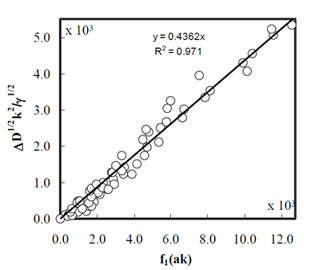Calculation of work of adhesion
In order to obtain the work of adhesion between the adhesive film and the flexible plate, we can first write the total energy of the system in terms of the distance of the contact line from the point of application of the load and then . The total energy consists of the elastic energy of the film, bending energy of the plate and the interfacial energy:
 |
(19.16) |
The first term in the above equation defines the bending energy of the plate per unit width: flexural rigidity x (curvature)2 ; the second term defines the elastic energy of the film and the third term is the interfacial energy per unit width that must be provided in order to create the new surface area between the plate and the adhesive film. Here  defines the thermodynamic work of adhesion. We can then find out the distance defines the thermodynamic work of adhesion. We can then find out the distance  for which the total energy of the system is minimized: for which the total energy of the system is minimized:  . Such an analysis finally leads to the following expression for the work of adhesion: . Such an analysis finally leads to the following expression for the work of adhesion:
 , where , where

|
(19.17) |

Figure 19.3 The work of adhesion can be calculated using equation 19.17, which can be rewritten as

|
(19.18) |
Where  and and  mJ/m2 is the surface energy of the poly(dimethylsiloxane) (PDMS) films. The above Figure shows the experimental data from several combinations of elastic film, flexible contacting plate scaled as in equation 19.18. From the slope of this curve the work of adhesion can be obtained as 45 mJ/m2 . mJ/m2 is the surface energy of the poly(dimethylsiloxane) (PDMS) films. The above Figure shows the experimental data from several combinations of elastic film, flexible contacting plate scaled as in equation 19.18. From the slope of this curve the work of adhesion can be obtained as 45 mJ/m2 .
|